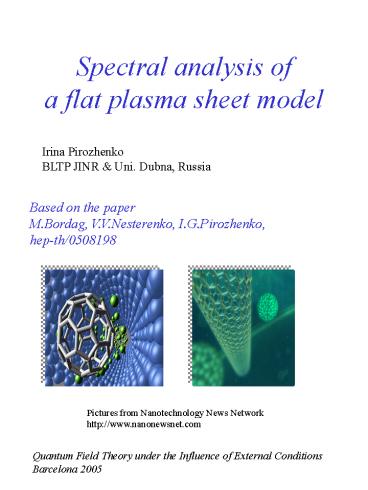Spectral analysis of a flat plasma sheet model - PowerPoint PPT Presentation
1 / 15
Title:
Spectral analysis of a flat plasma sheet model
Description:
Quantum Field Theory under the Influence of External Conditions Barcelona 2005 ... G.Barton, J.Phys. A 37, 1011 (2004), J.Phys.A 38, 2997 ( 2005) ... – PowerPoint PPT presentation
Number of Views:30
Avg rating:3.0/5.0
Title: Spectral analysis of a flat plasma sheet model
1
Spectral analysis of a flat plasma sheet model
Irina Pirozhenko BLTP JINR Uni. Dubna, Russia
Based on the paper M.Bordag, V.V.Nesterenko,
I.G.Pirozhenko, hep-th/0508198
Pictures from Nanotechnology News
Network http//www.nanonewsnet.com
Quantum Field Theory under the Influence of
External Conditions Barcelona 2005
2
Formulation of the model
G.Barton, J.Phys. A 37, 1011 (2004), J.Phys.A 38,
2997 ( 2005) It is supposed that infinitisemaly
thin two-dimensional plasma layers may loosely
imitate single graphite planes or the giant
carbon molecules or the
nanotubes. Effectively the model is described
by the Maxwell equations with charges and
currents distributed along the surface S
The equation of continuity
the charge density
the induced charge current
Quantum Field Theory under the Influence of
External Conditions Barcelona 2005
3
Formulation of the model (cont.)
The Newton second law applied to an individual
electron gives
The charges and electric currents induced on the
surface are determined be the parallel components
of electric field
Maxwell equations without sources
The matching conditions
Quantum Field Theory under the Influence of
External Conditions Barcelona 2005
4
Solution to the Maxwell Equations for a Flat
Plasma Sheet
Electric and magnetic Hertz vectors
each possessing only one nonzero component
For the TE-modes ( )
For the TM-modes ( )
Quantum Field Theory Under the Influence of
External Conditions Barcelona 2005
5
Solution to the Maxwell Equations for a Flat
Plasma Sheet (cont.)
Behaviour of the functions at infinity
Quantum Field Theory Under the Influence of
External Conditions Barcelona 2005
6
The scattering problem
The transverse electric modes
The spectral problem can be reformulated by
introducing the delta function potential
The scattering states for the TE-modes are
described by the functions
The reflection and transmission coefficients
The phase shift and the scattering matrix
Quantum Field Theory under the Influence of
External Conditions Barcelona 2005
7
Between the TE modes are there solutions which
go down at ?
Such solutions would have the form
Then from the matching conditions it follows that
There are no solutions with positive
No surface plasmons in TE sector!
There are no bound states in the potential
when
The spectrum of TE modes
Here corresponds to the free waves
propagating in the directions parallel to the
plasma layer, and stands for
one-dimensional scattering in the normal direction
Quantum Field Theory under the Influence of
External Conditions Barcelona 2005
8
The scattering of TM modes
Between the TM modes there are also solutions
which go down in the limit
From the TM matching conditions follows the
equation
The positive root is
The surface plasmon frequency
The photon spectrum
Quantum Field Theory under the Influence of
External Conditions Barcelona 2005
9
The spectral functions
The TE modes
the zeta function
the integrated heat kernel
The heat kernel expansion
10
The TM photon sector
the zeta function
The integrated heat kernel
The heat kernel expansion
The explicit heat kernel gives
11
The surface plasmon
The integral does not exist at any s. It is
impossible to define the spectral zeta function.
However the heat kernel can be constructed
explicitly!
nonstandard term!
Quantum Field Theory under the Influence of
External Conditions / Barcelona 2005
12
The Local Heat Kernel
The heat kernel for the TE modes factorizes
The representation in terms of the heat
potentials
Quantum Field Theory under the Influence of
External Conditions Barcelona 2005
13
The matching conditions give the system of
integral equations
The equaitions for
are solved by making use of the Laplace
transform
After the inverse Laplace transform we obtain
the heat kernel defined in a unique way in all
regions
The integrated heat kernel
Quantum Field Theory under the Influence of
External Conditions Barcelona 2005
14
The local heat kernel for the TM modes
- does not factorize
- however the technique of integral equations may
be applied again
The TM matching condition for the eigenfunctions
depends on the spectral parameter
Then the corresponding matching condition for the
local heat kernel is
The 1-d TM spectral problem
The eigenfunctions of the problem are connected
with the eigenfunctions of TE problem
(or 1-d delta potential) by the relation
the eigenvalues coincide!
15
Conclusion
- The spectrum of the model contains both
continuous - branches and bound states (surface plasmon).
- The surface plasmon part of the spectum does not
possess the - spectral zeta function and has an unusual heat
kernel expansion . - The heat kernel coefficients related
to the continuous - parts of the spectrum do not vanish.
- It means that the zeta regularization does not
give a unique result for - the Casimir energy in this model. Therefore a
reasonable physical - cut-off is required.
- The problems with spherical or cylindrical plasma
boundary are - of interest.
Quantum Field Theory under the Influence of
External Conditions Barcelona 2005































